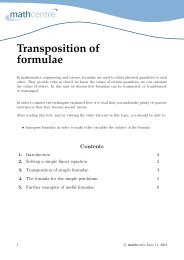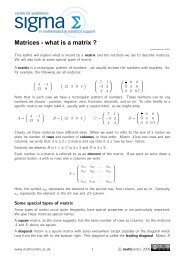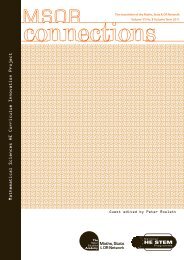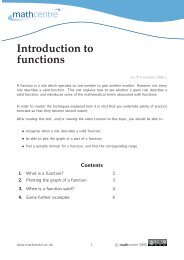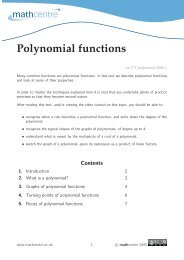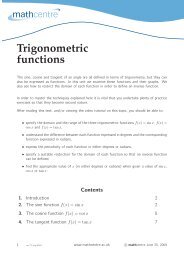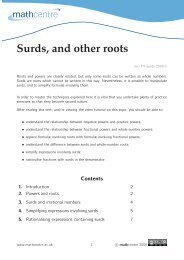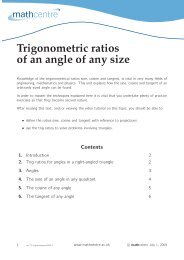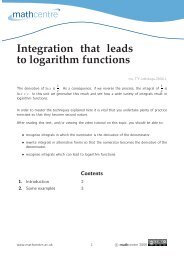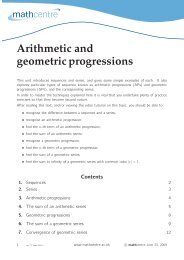Surds, and other roots - Math Centre
Surds, and other roots - Math Centre
Surds, and other roots - Math Centre
You also want an ePaper? Increase the reach of your titles
YUMPU automatically turns print PDFs into web optimized ePapers that Google loves.
<strong>Surds</strong>, <strong>and</strong> <strong>other</strong> <strong>roots</strong>Roots<strong>and</strong>powersarecloselyrelated,butonlysome<strong>roots</strong>canbewrittenaswholenumbers.<strong>Surds</strong>are<strong>roots</strong>whichcannotbewritteninthisway. Nevertheless,itispossibletomanipulatesurds,<strong>and</strong>tosimplifyformulæinvolvingthem.Inordertomasterthetechniquesexplainedhereitisvitalthatyouundertakeplentyofpracticeexercisessothattheybecomesecondnature.Afterreadingthistext,<strong>and</strong>/orviewingthevideotutorialonthistopic,youshouldbeableto:•underst<strong>and</strong>therelationshipbetweennegativepowers<strong>and</strong>positivepowers;•underst<strong>and</strong>therelationshipbetweenfractionalpowers<strong>and</strong>whole-numberpowers;•replaceformulæinvolving<strong>roots</strong>withformulæinvolvingfractionalpowers;•underst<strong>and</strong>thedifferencebetweensurds<strong>and</strong>whole-number<strong>roots</strong>;•simplifyexpressionsinvolvingsurds;•rationalisefractionswithsurdsinthedenominator.Contents1. Introduction 22. Powers<strong>and</strong><strong>roots</strong> 23. <strong>Surds</strong><strong>and</strong>irrationalnumbers 44. Simplifyingexpressionsinvolvingsurds 55. Rationalisingexpressionscontainingsurds 71 mc-TY-surds-2009-1 www.mathcentre.ac.uk c○mathcentreJune23,2009
1. IntroductionInthisunitwearegoingtoexplorenumberswrittenaspowers,<strong>and</strong>performsomecalculationsinvolvingthem. Inparticular, wearegoingtolookatsquare<strong>roots</strong>ofwholenumberswhichproduceirrationalnumbers—thatis,numberswhichcannotbewrittenasfractions.Thesearecalledsurds.2. Powers <strong>and</strong> <strong>roots</strong>Weknowthat2cubedis 2 × 2 × 2,<strong>and</strong>wesaythatwehave2raisedtothepower3,ortotheindex3. Aneasywayofwritingthisrepeatedmultiplicationisbyusinga‘superscript’,sothatwewouldwrite 2 3 :2 3 = 2 × 2 × 2 = 8 .Similarly,4cubedis 4 × 4 × 4,<strong>and</strong>equals64.Sowewrite4 3 = 4 × 4 × 4 = 64 .Butwhatifwehavenegativepowers?Whatwouldbethevalueof 4 −3 ?Tofindout,weshalllookatwhatweknowalready:4 3 = 4 × 4 × 4 = 64 ,4 2 = 4 × 4 = 16 ,4 1 = 4 = 4 ,<strong>and</strong>so 4 0 = 4 ÷ 4 = 1(becausetogettheansweryoudividethepreviousoneby4).Nowlet’scontinuethepattern:4 −1 = 1 ÷ 4 = 1 4 ,4 −2 1= 4 = 1 , 164 −3 1= 16 = 1 64<strong>and</strong> 164 = 1/43 . Soanegativepowergivesthereciprocalofthenumber—thatis,1overthenumber.Thus 4 −2 = 1/4 2 = 1 16 ,<strong>and</strong> 4−1 = 1/4 1 = 1 4 .Similarly,3 −2 = 1 3 2 = 1 9<strong>and</strong>5 −3 = 1 5 3 = 1125 .Acommonmisconceptionisthatsincethepowerisnegative,theresultmustbenegative: asyoucansee,thisisnotso.Nowweknowthat 4 0 = 1<strong>and</strong> 4 1 = 4,butwhatis 4 1/2 ?c○mathcentreJune23,2009 www.mathcentre.ac.uk 2 mc-TY-surds-2009-1
Usingtherulesofindices,weknowthat 4 1/2 × 4 1/2 = 4 1 = 4because 1 2 + 1 2 = 1.So 41/2 equals2,as 2 × 2 = 4.Therefore 4 1/2 isthesquarerootof4.Itiswrittenas √ 4<strong>and</strong>equals2:Similarly,4 1/2 = √ 4 = 2 .9 1/2 = √ 9 = 3 .Andingeneral,anynumber araisedtothepower 1 2a 1/2 = √ a .equalsthesquarerootof a:Sothepower,orindex,associatedwithsquare<strong>roots</strong>is 1 2 .Also,inthesamewaythattheindex 1 2representsthesquareroot,<strong>other</strong>fractionscanbeusedtorepresent<strong>other</strong><strong>roots</strong>.Thecuberootofthenumber 4iswrittenas4 1/3 = 3√ 4where 1 istheindexrepresentingcuberoot. Similarly,thefourthrootof5maybewrittenas35 1/4 = 4√ 5,<strong>and</strong>soon.The n-throotisrepresentedbytheindex 1/n,<strong>and</strong>the n-throotof aiswrittenasa 1/n = n√ a .So,forexample,ifwehave 3√ 64thenthisequals64tothepower 1 3 ;<strong>and</strong>then3√64 = 641/3= (4 × 4 × 4) 1/3= 4 .Therearesomeimportantpointsabout<strong>roots</strong>,orfractionalpowers,thatweneedtoremember.First,wecanwrite4 1/2 × 4 1/2 = 4√4 ×√4 = 4( √ 4) 2 = 4sothatthesquarerootof4,squared,givesyou4backagain. Infactthesquarerootofanynumber,squared,givesyouthatnumberbackagain.Next,ifwehaveaverysimplequadraticequationtosolve,suchas x 2 = 4,thenthesolutionsare x = +2or x = −2.Therearetwo<strong>roots</strong>,as (+2) × (+2) = 4<strong>and</strong>also (−2) × (−2) = 4.Wecanwritethe<strong>roots</strong>as ±2. Sonotall<strong>roots</strong>areunique. Butinalotofcircumstancesweonlyneedthepositiveroot,<strong>and</strong>youdonothavetoputaplussigninfrontofthesquarerootforthepositiveroot.Byconvention,ifthereisnosigninfrontofthesquarerootthentherootistakentobepositive.Onthe<strong>other</strong>h<strong>and</strong>,supposeweweregiven √ −9.Couldweworkthisout<strong>and</strong>getarealanswer?Now √−9 = (−9) 1/2 ,<strong>and</strong>sowearelookingforanumberwhichmultipliedbyitselfgives −9. Butthereisnosuchnumber,because 3 × 3 = 9<strong>and</strong>also (−3) × (−3) = 9.Soyoucannotfindthesquarerootofanegativenumber<strong>and</strong>getarealanswer.3 mc-TY-surds-2009-1 www.mathcentre.ac.uk c○mathcentreJune23,2009
Key PointThesquarerootof aiswrittenas a 1/2 <strong>and</strong>isequalto √ a.The n-throotof aiswrittenas a 1/n<strong>and</strong>isequalto n√ a.Theformula√ a ×√ a = acanbeusedtosimplifyexpressionsinvolvingsquare<strong>roots</strong>.Notall<strong>roots</strong>areunique,forexamplethesquarerootof4is2or −2,sometimeswrittenas±2.Butwhenwrittenwithoutasigninfront,thesquarerootrepresentsthepositiveroot.Youcannotfindthesquarerootofanegativenumber.3. <strong>Surds</strong> <strong>and</strong> irrational numbersWeshallnowlookatsomesquare<strong>roots</strong>inmoredetail. Take,forexample, √ √25:itsvalueis5.9Andthevalueof is 3 ,or 4 2 11. Sosomesquare<strong>roots</strong>canbeevaluatedaswholenumbersor2asfractions,in<strong>other</strong>wordsasrationalnumbers.Butwhatabout √ 2or √ 3?The<strong>roots</strong>tothesearenotwholenumbersorfractions,<strong>and</strong>sotheyhaveirrationalvalues.Theyareusuallywrittenasdecimalstoagivenapproximation.Forexample√2 = 1.414√3 = 1.732to3decimalplaces,to3decimalplaces.Whenwehavesquare<strong>roots</strong>whichgiveirrationalnumberswecallthemsurds. So √ 2<strong>and</strong> √ 3aresurds.Othersurdsare√5,√6,√7,√8,√10 <strong>and</strong>soon.<strong>Surds</strong>areoftenfoundwhenusingPythagoras’Theorem,<strong>and</strong>intrigonometry.So,wherepossible,itisusefultobeabletosimplifyexpressionsinvolvingsurds. Take,forexample, √ 8. Thiscanbewrittenas √ 4 × 2,whichwecanrewriteas √ 4 × √ 2,in<strong>other</strong>wordsas 2 √ 2:√8 =√4 × 2= √ 4 × √ 2= 2 √ 2.Ingeneral,thesquarerootofaproductistheproductofthesquare<strong>roots</strong>,<strong>and</strong>viceversa.Thisisusefultoknowwhensimplifyingsurdexpressions.c○mathcentreJune23,2009 www.mathcentre.ac.uk 4 mc-TY-surds-2009-1
Nowsupposewehavebeengiven √ 5 × √ 15. Atfirstglancethiscannotbesimplified. Butwecanrewritetheexpressionasthesquarerootof5times15,soitisthesquarerootof75,<strong>and</strong>75canbewrittenas25times5. But25isaperfectsquare,wecanusethistosimplifytheexpression.√5 ×√15 =√5 × 15= √ 75= √ 25 × 3= √ 25 × √ 3= 5 √ 3.Butwatchoutifyouaregiven √ 4 + 9,whichisthesquarerootof13. Thisdoesnotequal√4 +√9,whichis 2 + 3 = 5. Now5cannotbetheanswerasthatisthesquareroot25,notthesquarerootof13.Key PointIfapositivewholenumberisnotaperfectsquare,thenitssquarerootiscalledasurd.Asurdcannotbewrittenasafraction,<strong>and</strong>isanexampleofanirrationalnumber.4. Simplifying expressions involving surdsKnowingthecommonsquarenumberslike4,916,25,36<strong>and</strong>soonupto100isveryhelpfulwhensimplifyingsurdexpressions,becauseyouknowtheirsquare<strong>roots</strong>straightaway,<strong>and</strong>youcanusethemtosimplifymorecomplicatedexpressions. Supposewewereaskedtosimplifytheexpression √ 400 × √ 90:√400 ×√90 =√4 × 100 ×√9 × 10whichcannotbesimplifiedanyfurther.= √ 4 × √ 100 × √ 9 × √ 10= 2 × 10 × 3 × √ 10= 60 √ 10,Wecanalsosimplifytheexpression √ 2000/ √ 50.Weget√ √2000 2000√ = 50 50= √ 40= √ 4 × 10= √ 4 × √ 10= 2 √ 10.5 mc-TY-surds-2009-1 www.mathcentre.ac.uk c○mathcentreJune23,2009
Key PointThefollowingformulæmaybeusedtosimplifyexpressionsinvolvingsurds:√ab =√ a ×√b√ ab=√ a√b, .Ifwehaveaproductofbracketsinvolvingsurds,forexample (1 + √ 3)(2 − √ 2),wecanexp<strong>and</strong>outthebracketsintheusualway:(1 + √ 3)(2 − √ 2) = 2 − √ 2 + 2 √ 3 − √ 3 √ 2= 2 − √ 2 + 2 √ 3 − √ 6.Butwhatifwehavethisexpression, (1 + √ 3)(1 − √ 3)?Ifweexp<strong>and</strong>thisout<strong>and</strong>simplifytheanswer,weget(1 + √ 3)(1 − √ 3) = 1 − √ 3 + √ 3 − √ 3 √ 3 = 1 − √ 9 = 1 − 3 = −2 .Sotheproduct (1 + √ 3)(1 − √ 3)doesnotinvolvesurdsatall.Thisisanexampleofageneralresultknownasthedifferenceoftwosquares.Thisgeneralresultmaybewrittenasa 2 − b 2 = (a + b)(a − b)foranynumbers a<strong>and</strong> b.Inourexample a = 1<strong>and</strong> b = √ 3,so(1 + √ 3)(1 − √ 3) = 1 2 − ( √ 3) 2 = 1 − 3 = −2 .Theexpansionofthedifferenceoftwosquaresisan<strong>other</strong>usefulfacttoknow<strong>and</strong>remember.TheformulaforthedifferenceoftwosquaresisKey Pointa 2 − b 2 = (a + b)(a − b) .c○mathcentreJune23,2009 www.mathcentre.ac.uk 6 mc-TY-surds-2009-1
5. Rationalising expressions containing surdsSometimesincalculationsweobtainsurdsasdenominators,forexample 1/ √ 13. Itisbestnottogivesurdanswersinthisway.Instead,weuseatechniquecalledrationalisation.Thischangesthesurddenominator,whichisirrational,intoawholenumber.Toseehowtodothis,takeourexample 1/ √ 13.Torationalisethis,wemultiplybythefraction√13/√13whichisequalto1.Whenwemultiplybythisfractionwedonotchangethevalueofouroriginalexpression.Weobtain1√13=√1 13√ × √13 13=√1313 .Wecanalsousetheexpansionofthedifferenceoftwosquarestorationalisemorecomplicatedexpressionsinvolvingsurds.ExampleRationalisetheexpressionSolution11 + √ 2 .Ifwemultiplythisexpressionbythisfraction (1 − √ 2)/(1 − √ 2)wedonotchangeitsvalue,asthenewfractionisequalto1. Whenwedothis,weusetheformulaforthedifferenceoftwosquarestoworkout(1 + √ 2) × (1 − √ 2) ,<strong>and</strong>thatgivesus 1 2 − ( √ 2) 2 ,whichis 1 − 2 = −1. Sonowwehaveawholenumberinthedenominatorofourfraction,<strong>and</strong>wec<strong>and</strong>ividethrough.Weget11 + √ 2 = 11 + √ 2 × 1 − √ 21 − √ 21 − √ 2=1 2 − ( √ 2) 2= 1 − √ 2−1= −1 + √ 2= √ 2 − 1 .7 mc-TY-surds-2009-1 www.mathcentre.ac.uk c○mathcentreJune23,2009
ExampleRationalisetheexpression1√5 −√3.SolutionTorationalisethis,wemustmultiplyitbyafractionwhichequals1.Tochooseasuitablefraction,wethinkofthedifferenceoftwosquares. Asourexpressionhas √ 5 − √ 3inthedenominator,thefractiontouseis ( √ 5 + √ 3)over ( √ 5 + √ 3):1√5 −√3=====√ √1 5 + 3√ √ × √ √5 − 3 5 + 3√ √5 + 3( √ 5 − √ 3)( √ 5 + √ 3)√ √5 + 3( √ 5) 2 − ( √ 3)√ √ 25 + 3√2√5 32 + 2 .Key PointAsurdexpressionintheform1( √ a + √ b)or1( √ a − √ b)canbewrittenas c √ a + d √ bbyusingtheformulaforthedifferenceoftwosquares.Exercises1.Simplifythefollowingexpressions:(a)√40 ×√200 (b)√90 ×√600000 (c)√1000/√40 (d) (1 −√5)(1 +√5)(e) ( √ 7 + 3)( √ 7 − 3)2.Rationalisethefollowingexpressions:(a) 1/ √ 11 (b) 30/ √ 3 (c) 1/(1 − √ 3) (d) 1/( √ 7 + √ 2) (e) 2/( √ 5 − √ 7)Answersc○mathcentreJune23,2009 www.mathcentre.ac.uk 8 mc-TY-surds-2009-1
1. (a) 40 √ 5 (b) 3000 √ 6 (c) 5 (d) −4 (e) −22. (a)√11/11 (b) 10√3 (c) −12 − √ 3/2 (d)√7/5 −√2/5 (e) −√5 −√79 mc-TY-surds-2009-1 www.mathcentre.ac.uk c○mathcentreJune23,2009



